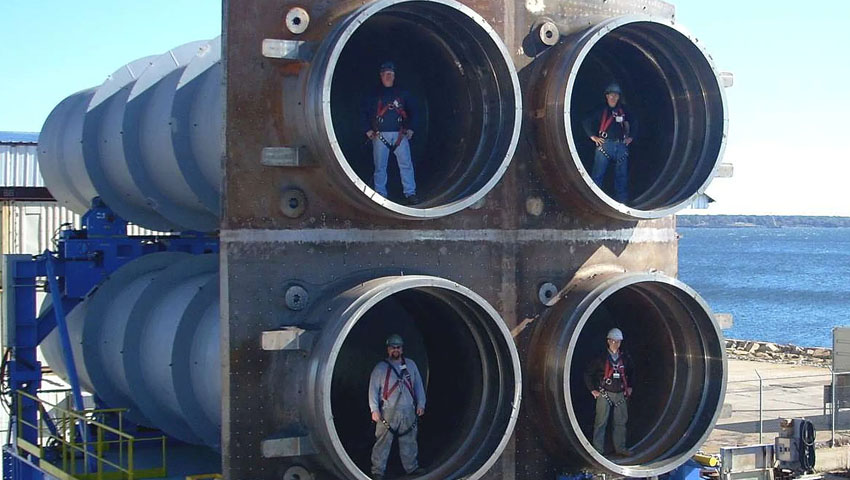With the detailed design phase of the $50 billion SEA 1000 program well underway and the nation’s long-range strike capabilities seemingly limited, should Australia opt to build the future submarines for and with a robust long-range strike and deterrence capability, beginning with Boat One?
Submarines are the ultimate force multiplier and strategic deterrent platform for many modern navies. Australia's Collins Class, despite a troubled early life, have quickly established themselves as some of the world's best conventionally-powered attack and guided missile submarines, providing Australia with a potent at-sea deterrence platform.
Building on this precedent, the Attack Class submarines will be required to fill a similar and possibly expanded deterrence role to that of the Collins Class vessels, providing enhanced range, time on station and an advanced suite of weapons systems in a regionally superior submarine platform.
ASPI executive director Peter Jennings highlighted the importance of these strategic deterrence capabilities to Defence Connect, saying, "We need to be placing more effort into developing the long-range strike capability, this includes things like cruise missiles, which can be launched by platforms across the ADF.
"We also need to place greater emphasis on upgrading the capability provided by Collins, not just as a stop-gap, but as an imperative, as these submarines will continue to form the point of our deterrence spear for some time yet."
While Defence Connect has extensively covered the evolution of Sweden's Gotland Class submarines, for which the existing Collins Class served as the design basis, recent developments made by both Sweden and the US in the space of submarine mounted, vertical launch modules provide interesting design concepts for integrating into Australia's future Attack Class submarines.
These developments provide a range of options for Australian consideration as the regional tactical and strategic environment continues to evolve and requires a nuanced, long-term strategy guiding the development and implementation from the design phase in Australia's future submarines.
BAE Systems Virginia Payload Module (VPM): The VPM is an additional mid-body section being integrated into the US Navy’s Virginia Class submarines, beginning with the second boat of Block V to begin construction in 2019.
Each VPM contains four large-diameter payload tubes, each capable of storing and launching up to seven Tomahawk cruise missiles. Accessible while at sea, the VPM also offers an unprecedented amount of flexibility in the potential integration of future payloads.
Joe Senftle, vice president and general manager of weapon systems at BAE Systems, said, "The new Virginia Payload Module will bring an additional 28 missiles to each Virginia Class submarine, tripling their payload strike capacity."
The additional Virginia Payload Tubes (VPT) will add to the existing tubes located in the bow-mounted weapons system of the Virginia Class submarines, which are capable of launching six Tomahawk cruise missiles.
While the Virginia Class vessels are large, nuclear powered, fast attack submarines, the integration and proof-of-concept successfully trialed in the refit of a number of Ohio Class ballistic missile submarines to serve as cruise missile submarines, in a pseudo-'arsenal ship' configuration, serves as an invaluable concept for Australian consideration.
Saab Kockums A26 Vertical Launch System: The Saab A26 is an evolution of the Gotland Class vessels with two distinct variants focusing on different operational parameters. The Oceanic - Extended Range variant incorporates three, six-round (total of 18) vertical launch tubes, similar in function to the VPM.
The design and planned incorporation of this 10-metre module is the first time such a vertical launch module has been designed for incorporating into a conventionally-powered submarine platform, as such land-attack cruise missile capabilities are traditionally the realm of larger, nuclear submarines.
Such payload modules are not limited to land attack missile and strike capabilities, as key under-sea technologies including unmanned underwater vehicles (UUV) for intelligence, surveillance and reconnaissance, anti-ship attack capacity, mine hunting and special forces support enhance the operational and capability profiles of submarines.
At the very minimum the design, manufacture and refit of a module, similar to the VPM, on the conventionally powered submarine, like the evolved and modernised Gotland Class vessels, upon which Australia's Collins Class are based, serves as a proof-of-concept for implementation in some of the younger Collins Class vessels to serve as an expansion of their life and to avoid any capability gap.
Your thoughts
As an island nation, Australia is defined by its relationship and access to the ocean, with strategic sea-lines-of-communication support over 90 per cent of global trade, a result of the cost effective and reliable nature of sea transport. Indo-Pacific Asia is at the epicentre of the global maritime trade, with about US$5 trillion worth of trade flowing through the South China Sea and the strategic waterways and choke points of south-east Asia annually.
The Indian Ocean and its critical global sea-lines-of-communication are responsible for more than 80 per cent of the world's seaborne trade in critical energy supplies, namely oil and natural gas, which serve as the lifeblood of any advanced economy.
Submarines are critical to the nation's ability to protect these strategically vital waterways and key naval assets, as well as providing a viable tactical and strategic deterrent and ensure the nation's enduring national and economic security – recognising this, the previously posed questions will serve as conversation starting points.
However, given the geographic area of responsibility Australia will become increasingly responsible for and dependent on, is the RAN and the recapitalisation and conventionally-focused modernisation program for Australia's submarine fleet enough for Australia to maintain its qualitative and quantitative lead over regional peers?
Traditionally, Australia has focused on a platform-for-platform acquisition program – focused on replacing, modernising or upgrading key capabilities on a like-for-like basis without a guiding policy, doctrine or strategy, limiting the overall effectiveness, survivability and capability of the RAN. Let us know your thoughts in the comments section below, or get in touch with



